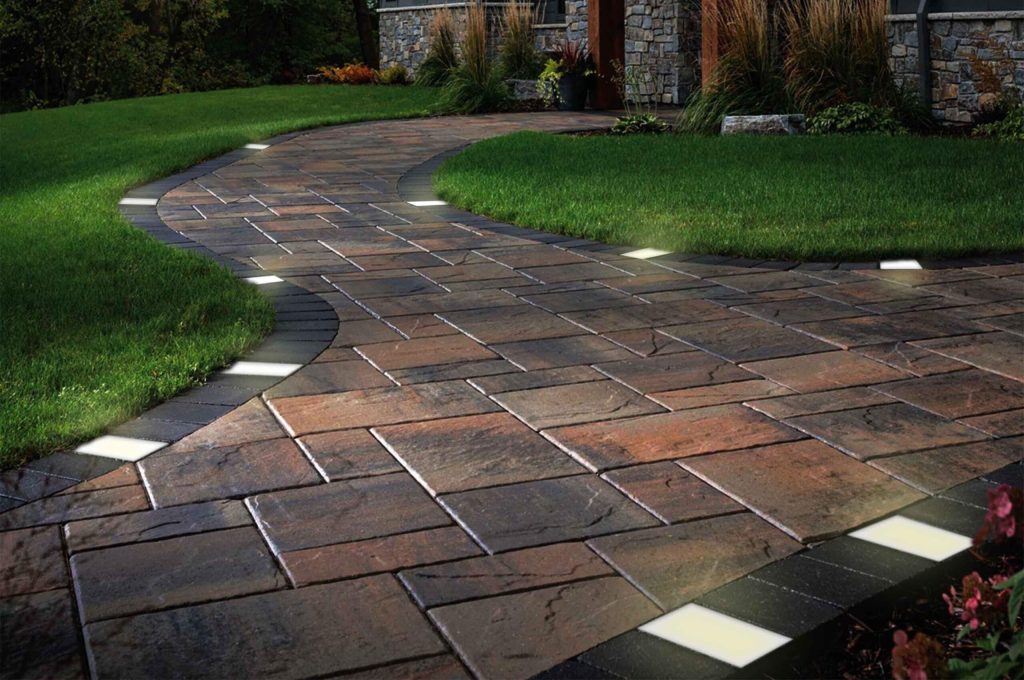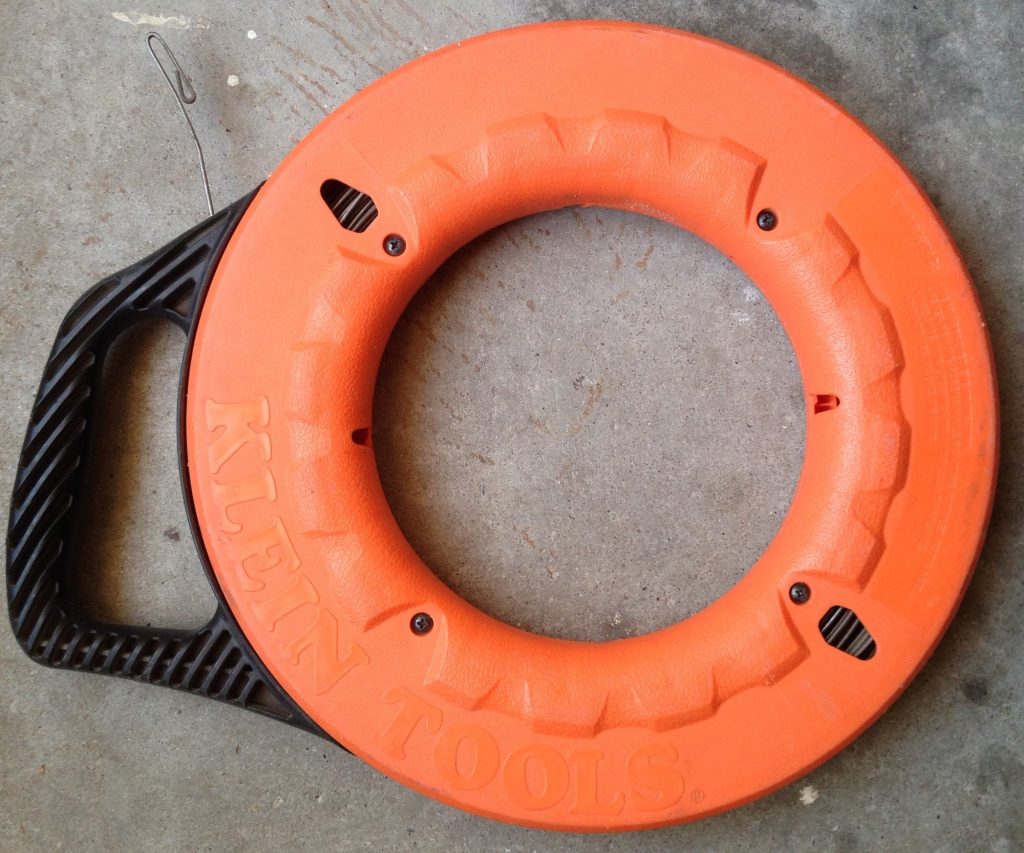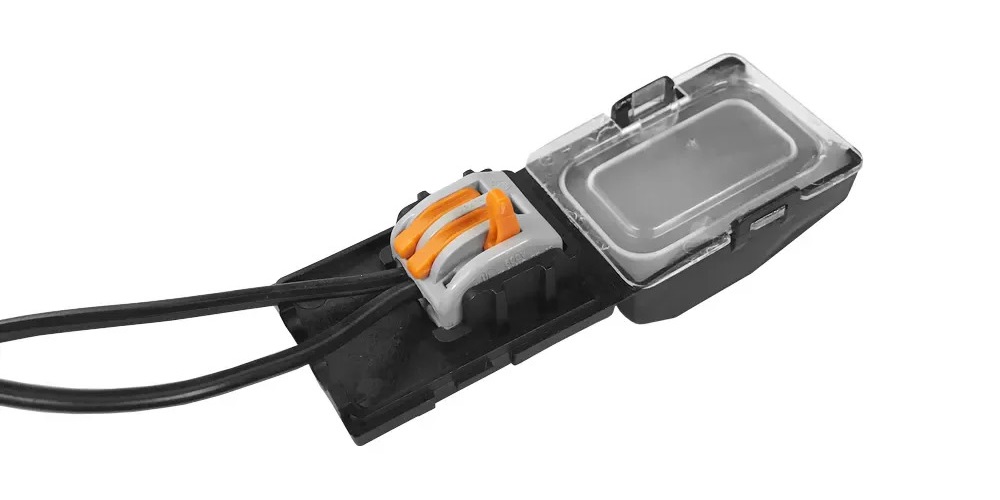Lighting the Way to Beauty and Safety
The Brilliance of Landscape Lighting
Landscape lighting serves as a beacon of elegance, transforming ordinary outdoor spaces into enchanting havens. Aesthetically, it highlights architectural features, garden elements, and walking paths, adding an ethereal ambiance to your property after sundown.
Landscape lighting isn’t merely about curating an inviting atmosphere; it also significantly enhances security. Illuminated exteriors can deter unwanted intruders and help prevent accidents caused by tripping over unseen objects in the dark. Furthermore, the light can guide guests towards the entrance or around the yard, providing visibility during evening gatherings.
Underneath the Surface: The Essentiality of Under-Sidewalk Wiring
The magic of landscape lighting lies not just in fitting attractive luminaires but also in executing a flawless installation process, particularly when it comes to wiring under sidewalks. This step is crucial for any landscape lighting system that extends beyond one side of a sidewalk or driveway.

By installing wiring under a sidewalk, you’re creating an integrated network of light that unifies both sides of your walkway. This process allows for seamless lighting without distracting cords running across your path.
A Clear Path: Understanding the Installation Process
Introducing electrical wiring into your landscape might seem like a daunting task, with concerns about safety and aesthetics paramount in one’s mind. However, understanding how to route wires beneath sidewalks can alleviate these worries and simplify the overall process. It is essential to remember that this procedure involves more than just burying wires haphazardly; it includes ensuring proper depth placement, using suitable types of conduits – plastic tubes that house and protect wires underground – and employing techniques such as fish tape guiding to ensure successful cable installation.
Safety First: An Uncompromising Approach
The installation of landscape lighting might be a hands-on task, but it doesn’t translate to unnecessary risks. Always prioritize safety when dealing with electrical systems and digging around your yard.
Utilities must be marked beforehand to avoid damage and potential accidents. Using appropriate protective gear such as gloves and safety glasses is recommended when running wires, digging trenches, or cutting conduits.
Cover Every Detail: Installing with Precision
The beauty of an expertly installed landscape lighting system lies in its invisibility during the day and its transformative effect at night. Achieving this requires meticulous planning, careful execution, and unwavering attention to detail in every aspect of the process, from selecting quality materials to ensuring precise positioning of each fixture. Dedicate yourself to proper installation techniques from the beginning so that you can enjoy a beautifully lit landscape without intrusion or mishaps down the line.
A Toolkit for Success: Essential Tools and Materials
Before plunging into the task of installing landscape lighting wire under a sidewalk, it is essential to gather the proper tools and materials. Each serves a specific function that brings you closer to the ultimate goal: a beautifully lit landscape.
Tools of the Trade
A shovel is indispensable for this job. It will be used to dig trenches along the pathway where your wires will be laid. A pointed garden shovel works best as its sharp tip allows it to easily penetrate the ground, while its narrow width will ensure your trench doesn’t needlessly disrupt too much of your landscape.
PVC pipe should also be part of your arsenal. The use of PVC pipe acts as a protective conduit for your wires. When running electrical cables underground, especially under paths like sidewalks, PVC pipes shield them from potential damage caused by external forces such as pressure or sharp objects.

Fish tape is another key tool in this endeavor. This flat steel ribbon is perfect for threading through confined spaces like our PVC conduit due to its flexibility yet robust nature, allowing it to maintain direction even when traveling long distances under sidewalks.
The Right Wire for Landscape Lighting
Choosing the right wire type could be likened to choosing the right foundation for a house; wrong choices can lead to unpredictable outcomes and possible failures down the line. For outdoor lighting projects such as ours, direct burial cable (DBC) is typically recommended. These types of cables are designed specifically to withstand damp soil conditions and potential physical disruptions without compromising their functionality or integrity.
The gauge (thickness) of your wire should also match up with your intended use case. A 12-gauge wire would suffice in most cases, offering durability and resistance against voltage drop, which can cause lights at further distances from power sources not to shine as brightly as those closer by.
Safeguarding Your Endeavor
Safety should never be an afterthought during any DIY project, especially when dealing with electricity and physical labor such as digging. A pair of sturdy gloves should be at arm’s reach during this project. Beyond keeping your hands clean, gloves provide protection against accidental cuts from sharp tools or objects in the soil.
Safety glasses are another must-have. They protect your eyes from any unexpected debris flying up while you are digging. More importantly, they are a crucial safety measure when dealing with electrical wires to protect against any potential sparks or short circuits.
The correct tools, materials, and safety equipment can make the difference between a seamless installation process and one filled with unnecessary hiccups. With these vital resources at your disposal, you will be well-equipped to install your landscape lighting wire.
Installing Landscape Lighting Wire Under Sidewalk
Preliminary Steps Before Installation
Choosing the Right Location for Your Lights
Before laying a single foot of wire, one must judiciously determine the ideal locations for the landscape lights. Considering both aesthetic appeal and practical lighting is paramount. Identify which architectural features or landscaping elements you intend to highlight.
Also, ponder on the safety aspects of lighting, such as illuminating stairs, paths, or hazardous areas. Bear in mind that landscape lighting is meant to add depth and texture at night.
Hence, selecting locations with interesting features like unique plants or stylish stonework can magnify your garden’s nocturnal charm. Consult with a landscaping professional or designer if you wish to capture this allure effectively.
Consider potential growth and changes in your landscape over time; place fixtures where they won’t be disrupted by maturing vegetation or future renovations.
Avoid placing lights near windows where they will shine directly into your home. This not only diminishes the effect of your lighting but can also cause unwanted glare inside your dwelling.
Proximity to an energy source is another fundamental factor while deciding upon a location for your lights; ensure it’s close enough to connect without excessive wire length.
Planning the Lighting Layout
In planning the layout of your lights, begin by visualizing or sketching your yard space from various angles and consider how lighting can enhance each view. Identify focal points that draw attention and create engaging viewpoints from different perspectives.
Your planning should involve determining what types of light fixtures will best illuminate each designated area. Whether spotlighting tree canopies with uplights, casting gentle glows on pathways using path lights, or highlighting water features using submersible pond lights, each fixture adds its own nuance to the nightscape tableau.
The course of the wiring needs to be meticulously planned, taking into account the shortest possible distance between each light fixture and the transformer while also considering any obstacles such as trees, buildings, or sidewalks. Planning your layout this way can save you valuable resources in terms of wire length and trench digging labor.
Ensure to leave some buffer in your layout plan for future changes or expansions. Try keeping a few additional feet of wire at each fixture location for adjustments if needed. Remember to space out your lights properly. Overcrowding fixtures can lead to an unpleasant glare instead of a soothing ambiance.
Marking Utilities Before Digging
Prior to plunging that shovel into the ground, it’s crucial you have a clear understanding of what lies beneath. Striking buried utility lines while digging can lead to dangerous consequences and hefty repair expenses.
A prudent first step is calling 811 – a federally designated phone number for homeowners planning outdoor projects that involve digging. By contacting 811 at least a few days before you start your project, utility companies will mark their buried lines with flags or paint so you know where not to dig.

In addition to checking with utilities about underground gas or water lines, make sure there are no irrigation lines, drain pipes, or other buried cables in your intended trench path that could complicate matters during installation. If you’re unsure about any markings left by utility companies or if their markers seem unclear, don’t hesitate in reaching out again for further clarification.
Safety should always be your prime concern while conducting such projects. To conclude this preliminary phase, once utilities have been marked and confirmed as safe from disruption, only then should you proceed with the actual groundwork, safeguarding not just yourself but also ensuring uninterrupted service delivery from these utilities.
Eureka Beneath the Earth: Digging the Trench
Begin the process by digging a trench along your sidewalk. It is crucial to observe that the depth of this trench should be between 18 and 24 inches, as per the National Electric Code’s guidelines. This depth is ideal; it ensures that your lighting wire will be well protected from everyday surface activities and potential damages.
The act of digging should never be done haphazardly. Careless or rushed digging could cause unnecessary harm to your property’s aesthetics or, even worse, cause damage to other buried utility lines. Therefore, initially use a shovel to gently remove layers of grass or topsoil.
Once you reach subsoil, which is typically harder and less fertile than topsoil, you can increase your vigor in digging. When digging near tree roots or other delicate elements like sprinkler lines in the yard, exercise extreme caution. The idea here is not only to avoid destruction but also to prevent triggering future problems like root rot in trees.
A valuable tip for efficient and safe digging is using a trenching spade (a narrow type of shovel) or a power trencher if available. These tools will provide cleaner cuts into the soil while minimizing possible physical strain. As you dig this path for lighting, remember that patience and precision are more essential than brute force.
A Tunnel for Light: Laying PVC Conduit
Once you have successfully excavated your trench, it’s time for laying down PVC conduit – an essential part in this installation process that functions as a protective tunnel for your wire. The size of conduit needed primarily depends on your wire’s diameter and possibly future additions to the lighting system – typically, though, half an inch of conduit will suffice for most household landscape lighting applications.

PVC conduits come in different types with varying degrees of rigidity and flexibility – choose one suitable for burial and resistant to decay. The conduit should be laid lengthwise along the trench, with both ends extending beyond the sidewalk.
Securing the conduit in place might require the use of PVC adhesive at joints or bends, if any exist. If you live in an area with seismic activity, some movement allowance might be necessary.
Slithering Lighting: Running Wire Through the Conduit
After your conduit is firmly placed, it’s time to introduce your landscape lighting wire to its new home. This process is made effortless by using a tool called fish tape. To begin with, ensure one end of your wire is securely attached to the fish tape – electrical or duct tape can be used for this attachment.
Insert the fish tape from one end of your conduit and push it all through until it emerges on the other side, then gently pull your wire through. During this operation, make sure you leave enough wire length at both ends for connections to your power source and lighting fixtures, respectively.
I recommend leaving an extra foot at each end – it’s better to have surplus than shortfall. As you run your wire through its conduit path smoothly like a slithering snake in its burrow, remember never to force or jam it; too much stress could damage it.
Reworking Geography: Backfilling the Trench
With all elements in place beneath ground level now, it’s time to return displaced soil back into the trench – an act known as backfilling. Backfill using small handfuls or shovelfuls of soil initially while being careful not to dislodge or damage newly installed conduits and wires.
Once secure, you can increase backfill speed but keep monitoring the stability of installations as you proceed. The goal isn’t just about filling up this trench but also ensuring that no voids are left behind that might collect water; therefore, compact soil lightly during backfilling – a flat tool like the back of a rake can be useful here.
After completely filling the trench, smoothen your work area and replace any grass pieces that might have been removed during digging for a well-blended look. Your landscape should look as though it was never disturbed – but with an added spark of lighting beneath its skin. At this juncture, you’ve successfully installed your landscape lighting wire under the sidewalk.
Connecting Wires to Landscape Lights
Stripping the Wire Ends: A Detailed Approach
To connect landscape lighting, the hurdle of stripping the wire ends must first be surmounted. The purpose of stripping is to expose enough copper wire for a secure connection with your landscape lights. Start by determining how much insulation needs to be removed from each end of the wire. Typically, about half an inch is sufficient.
Position your wire stripper at this measured length and squeeze firmly but carefully – excessive pressure might inadvertently sever essential conductor strands. Once you’re satisfied with your grip on the stripper, pull it toward the end of the wire gently but steadily.
The insulation should slide off smoothly, revealing gleaming copper beneath. It’s critical at this point to inspect the freshly exposed conductor for any sign of damage or fraying; these may compromise your connection. If any strand appears misaligned or broken, snip off the damaged section and start anew. Repeating these steps on both ends ensures ready-to-connect wires for your landscape lights.
Making Secure Connections: A Guide to Using Proper Connectors
Following successful stripping comes one of the most crucial aspects: making secure connections using proper connectors. Direct-burial connectors are generally recommended for their moisture-resistant nature – a vital feature considering outdoor placements.
To begin with, insert one stripped end into either slot in your connector and push until resistance is felt; this indicates that it has made contact with metal inside. Repeat similar steps with another cable from one of your lights into another slot in the same connector.

A firm and reliable connection necessitates twisting or crimping connectors as specified by their manufacturers’ instructions. An additional layer of silicone-filled tube can be added over connectors for extra protection against elements – a consideration worth remembering for the longevity of your landscape lights.
Repeating this process with all wires from all lights completes this sub-stage. Proceed to perform a quick visual inspection to guarantee stability of connections before moving forward.
Testing Lights Before Final Burial: The Last Preemptive Measure
You have stripped your wires and connected them impeccably, but one final step remains before final burial – testing your lights. This step is essential in preempting potential pitfalls that could render prior efforts fruitless.
Proceed by reconnecting every light fixture to its corresponding wire. Then, switch on the power from the electrical source to verify the functioning status of each light. If a light fails, ensure its bulb is tightly screwed and connections are properly made. If it still doesn’t work, consider changing the bulb or inspecting the wiring for possible faults.
Your landscape lighting system should be aglow at this point, basking in the anticipated splendor of your hard work. Affirmation via successful testing provides confidence that you’re ready for the final burial stage – an assurance that your painstaking labor will soon shine beautifully on the night’s canvas.
Maintenance and Troubleshooting Tips: Ensuring Longevity of Landscape Lighting
Regular Inspection Schedule: An Ounce of Prevention is Worth a Pound of Cure
A paramount element to ensuring the durability and function of your landscape lighting is a regular inspection schedule. Consistent checks every three months can prevent foreseeable issues, keeping the beauty and security of your exterior spaces intact.
A superficial inspection should include verifying that all lights are functioning correctly, checking for signs of wear on the light fixtures, and assessing any visible wiring for damage. More in-depth inspections conducted annually will involve inspecting the buried conduit for any potential breaches, with a particular focus on areas beneath high-traffic sidewalks or driveways.
Regular monitoring reduces the risk of severe damage resulting from negligence. Remember to always switch off the power supply before carrying out these inspections to ensure safety. The goal behind implementing a regular inspection schedule is mitigation; catching minor issues before they escalate into major problems not only saves money but also extends the longevity of your landscape lighting system.
Common Issues & Remedies: Lighting the Path to Solutions
Landscape lighting systems are not immune to issues, despite our best efforts at prevention. However, armed with knowledge about common problems, you can readily address these challenges swiftly and effectively.
One common issue includes lights failing to illuminate due to bulb burnout or fixture damage. If multiple lights are out simultaneously, this could signal an issue with circuit breakers or transformers that may require professional assistance.
Another common problem involves wires being frayed or cut as a result of weather elements or rodent activity. Regularly checking visible wiring ensures these issues are caught early, reducing costs in repair or replacement parts.
Poorly aimed lights may lead to inefficient lighting, which detracts from the beauty and security benefits landscape lighting offers. Simple adjustments can optimize light directionality for enhanced aesthetic appeal.
Changes in landscape elements like plants or trees over time can necessitate relocation of lighting fixtures. Flexibility in adapting your lighting setup to accommodate these natural changes ensures maximum longevity and effectiveness from your system.
Conclusion: How to Install Landscape Lighting Wire Under Sidewalk?
In the final analysis, the installation, maintenance, and troubleshooting of landscape lighting wire under the sidewalk is a sound investment in both the aesthetics and security of your property. Armed with this knowledge, you should approach this task with confidence, knowing each step brings you closer to enhancing your outdoor spaces’ beauty and safety.
Embrace this opportunity to light up your surroundings as a chance to showcase your creativity, all while adding value to your property. Remember that with regular inspections and proactive troubleshooting, you can ensure that this investment continues to shine brightly for years to come.
You may also be interested in the following posts:
